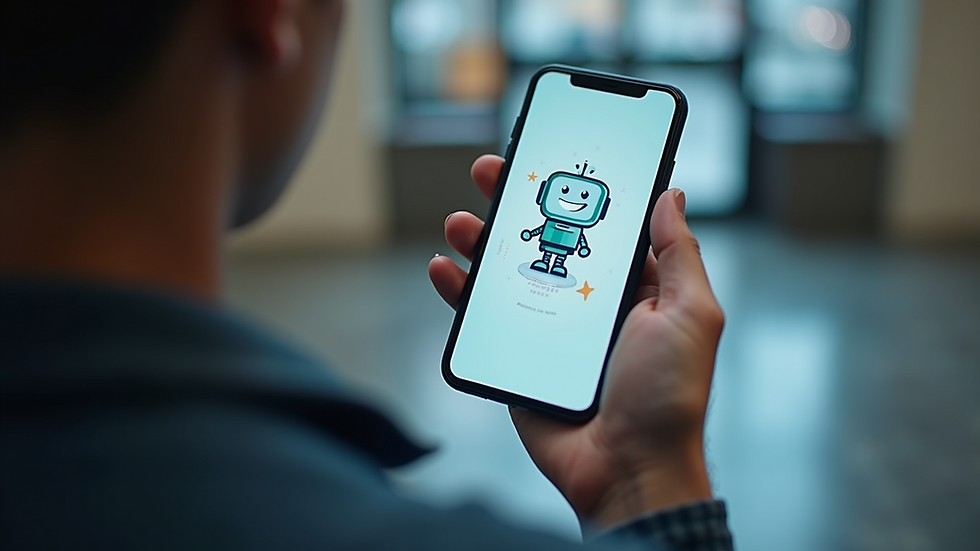Maximize Chatbot Engagement: Top Tips for AI Chatbots
- Bornil Banerjee
- Jul 26
- 4 min read
In today's digital world, chatbots have become essential tools for businesses. They provide instant support, answer questions, and engage customers in real-time. However, not all chatbots are created equal. To truly maximize engagement, you need to implement strategies that make your chatbot not just functional, but also enjoyable to interact with.
In this post, we will explore top tips for enhancing chatbot engagement. Whether you are a business owner, a marketer, or a tech enthusiast, these insights will help you create a more effective chatbot experience.
Understand Your Audience
The first step in maximizing chatbot engagement is understanding your audience. Who are they? What do they want?
Research Your Users: Conduct surveys or interviews to gather insights about your target audience. Understand their preferences, pain points, and expectations.
Create User Personas: Develop detailed profiles of your ideal users. This will help you tailor your chatbot's responses and tone to meet their needs.
By knowing your audience, you can create a chatbot that resonates with them.
Personalize Interactions
Personalization is key to making users feel valued. A chatbot that remembers user preferences and past interactions can significantly enhance engagement.
Use Names: Address users by their names. This simple touch can make conversations feel more personal.
Tailor Recommendations: If your chatbot can suggest products or services based on previous interactions, users are more likely to engage.
For example, if a user frequently asks about running shoes, your chatbot can proactively suggest new arrivals in that category.
Keep It Conversational
A chatbot should feel like a conversation, not a transaction.
Use Natural Language: Avoid robotic responses. Instead, use a friendly and conversational tone.
Incorporate Humor: A little humor can go a long way in making interactions enjoyable. Just ensure it aligns with your brand voice.
Ask Open-Ended Questions: Encourage users to share more by asking questions that require more than a yes or no answer.
For instance, instead of asking, "Do you need help?" try "What can I assist you with today?"
Provide Quick and Accurate Responses
Users expect quick answers. If your chatbot takes too long to respond, they may lose interest.
Optimize Response Time: Ensure your chatbot can handle multiple queries simultaneously.
Use FAQs: Incorporate a database of frequently asked questions. This allows your chatbot to provide instant answers to common inquiries.
Escalate When Necessary: If the chatbot cannot answer a question, it should seamlessly transfer the user to a human representative.
Design an Intuitive User Interface
The design of your chatbot can significantly impact user engagement.
Simple Navigation: Ensure users can easily navigate through options. Use buttons and quick replies to guide them.
Visual Elements: Incorporate images or emojis to make conversations more engaging.
Mobile-Friendly Design: Many users will interact with your chatbot on mobile devices. Ensure the design is responsive and easy to use on smaller screens.
Use Engaging Content
Content is king, even in chatbot interactions.
Share Valuable Information: Provide users with tips, articles, or resources that are relevant to their interests.
Incorporate Multimedia: Use images, videos, or GIFs to make interactions more dynamic.
Gamify the Experience: Consider adding quizzes or games that users can engage with. This can make the experience fun and memorable.
Monitor and Analyze Performance
To improve your chatbot, you need to monitor its performance regularly.
Track Engagement Metrics: Analyze data such as user retention, response times, and satisfaction ratings.
Gather Feedback: Encourage users to provide feedback on their experience. This can help you identify areas for improvement.
Iterate and Improve: Use the insights gained from monitoring to make necessary adjustments. Continuous improvement is key to maintaining high engagement levels.
Leverage AI and Machine Learning
Artificial intelligence can enhance your chatbot's capabilities.
Natural Language Processing (NLP): Implement NLP to help your chatbot understand user intent better. This allows for more accurate responses.
Machine Learning: Use machine learning algorithms to analyze user interactions and improve responses over time.
By leveraging AI, your chatbot can become smarter and more efficient, leading to higher engagement.
Create a Friendly Personality
A chatbot with a distinct personality can make interactions more enjoyable.
Define a Brand Voice: Establish a consistent tone that reflects your brand.
Be Approachable: Ensure your chatbot comes across as friendly and helpful.
Use Character Traits: Consider giving your chatbot unique traits that make it relatable.
For example, a chatbot for a coffee shop could have a cheerful and energetic personality, making users feel excited about their next cup of coffee.
Test and Optimize Regularly
Regular testing is crucial for maintaining an engaging chatbot.
A/B Testing: Experiment with different responses, designs, and features to see what resonates best with users.
User Testing: Involve real users in testing your chatbot. Their feedback can provide valuable insights.
Stay Updated: Keep up with the latest trends in chatbot technology and user preferences.
By continuously testing and optimizing, you can ensure your chatbot remains engaging and effective.
Foster a Community
Encouraging users to engage with each other can enhance the overall experience.
Create Forums or Groups: Consider setting up online communities where users can share experiences and tips.
Encourage User-Generated Content: Invite users to share their stories or feedback. This can create a sense of belonging.
Host Events or Webinars: Organize events where users can interact with your brand and each other.
Building a community around your chatbot can lead to increased engagement and loyalty.
Conclusion: The Path to Engaging Chatbots
Maximizing chatbot engagement is an ongoing journey. By understanding your audience, personalizing interactions, and continuously optimizing your chatbot, you can create a valuable tool that enhances user experience.
Remember, the goal is not just to provide answers but to create meaningful interactions. With the right strategies in place, your chatbot can become a powerful asset for your business.



Comments